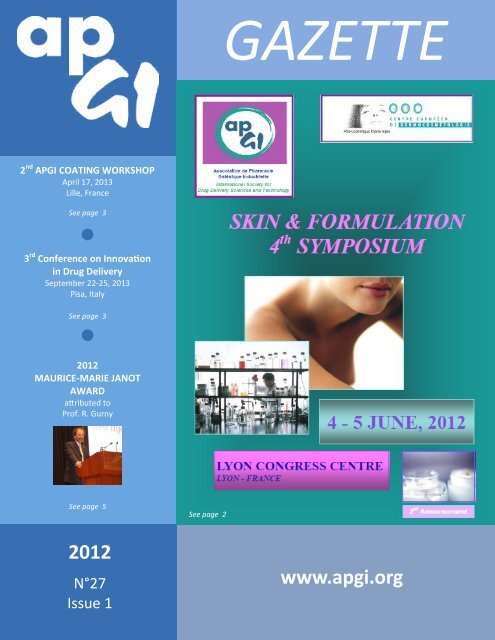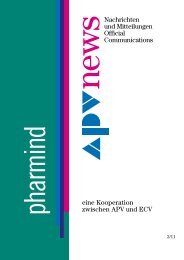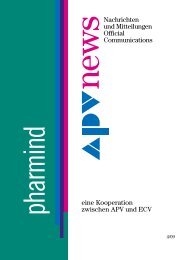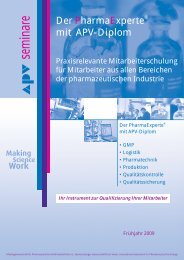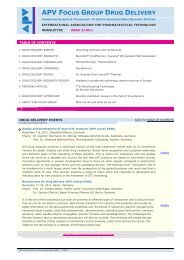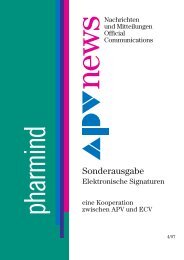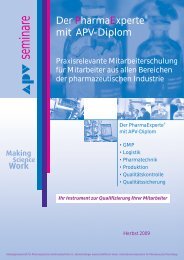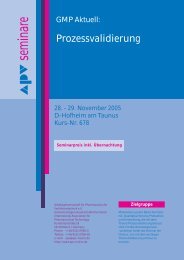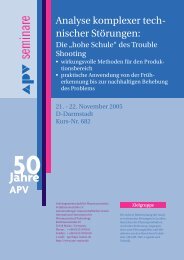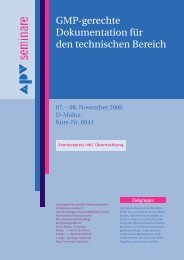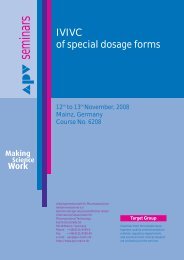New Technologies - APV
New Technologies - APV
New Technologies - APV
You also want an ePaper? Increase the reach of your titles
YUMPU automatically turns print PDFs into web optimized ePapers that Google loves.
2 nd APGI COATING WORKSHOP<br />
April 17, 2013<br />
Lille, France<br />
See page 3<br />
3 rd Conference on Innovation<br />
in Drug Delivery<br />
September 22-25, 2013<br />
Pisa, Italy<br />
See page 3<br />
2012<br />
MAURICE-MARIE JANOT<br />
AWARD<br />
attributed to<br />
Prof. R. Gurny<br />
See page 5<br />
2012<br />
N°27<br />
Issue 1<br />
See page 2<br />
GAZETTE<br />
www.apgi.org
APGI board<br />
Président : Pr. Juergen Siepmann<br />
Vice-Président : Dr. Vincent Jannin<br />
Trésorière : Dr. Marie-Pierre Flament<br />
Secrétaire : Pr. Odile Chambin<br />
Membre : Dr. Maria Teresa Peracchia<br />
Membre : Dr. Karine Andrieux<br />
APGI council<br />
Pr. Philippe Arnaud<br />
Dr. Karine Andrieux<br />
Dr. Emeline Berlier<br />
Dr. Amélie Bochot<br />
Dr. Marie-Alexandrine Bolzinger<br />
Dr. Kawthar Bouchemal<br />
Dr. Sandrine Bourgeois<br />
Dr. Régis Cazes<br />
Dr. Renée de Challemaison<br />
Pr. Odile Chambin<br />
Dr. Caroline Chemin<br />
Pr. Dominique Chulia<br />
Dr. Michel Deleers<br />
Dr. Marie-Pierre Flament<br />
Dr. Alexandre Gil<br />
Dr. Vincent Jannin<br />
Dr. Caroline Lemarchand<br />
Dr. Maria-Teresa Perrachia<br />
Pr. Véronique Préat<br />
Dr. Christel Raffournier<br />
Dr. Florence Siepmann<br />
Pr. Juergen Siepmann<br />
Dr. Céline Valéry<br />
Pr. Pascal Wehrlé<br />
SOMMAIRE<br />
CONTENT<br />
Editorial 1<br />
International <strong>New</strong>s 2<br />
Skin & Formulation 4 th Symposium 2<br />
2 nd APGI Coating workshop 3<br />
3 rd Conference on Innovation in Drug Delivery 3<br />
8 th World Meeting 4<br />
Maurice-Marie Janot Award 2012 5<br />
JDDST Awards 6<br />
9 th World Meeting 6<br />
In Memoriam –Professor André Moës 7<br />
Master of advanced studies in Toxicology 8<br />
<strong>New</strong> <strong>Technologies</strong> 8<br />
Micronized APIs in direct compression 8<br />
Inhalation Technology 12<br />
Agenda 16<br />
XXXXXXXXXXXXXXXXXXXXXXXXXXX<br />
Call for APGI Thesis award 2011<br />
This annual award, granted jointly by SANOFI and APGI, recognize theses written as the culmination<br />
of the Pharmaceutical Technology PhD programme.<br />
If you have defended your PhD thesis in 2011, you can apply for the APGI Young Investigator<br />
Award 2011. The amount of the Prize is 1500 € and it will be awarded during an international<br />
congress organized by Apgi (travel expenses to the congress will be deducted from the amount of<br />
the Prize). No registration fee for the conference will be charged. To apply, please send, by September<br />
10, 2012, three copies of your thesis manuscript (hard copy only) and a short curriculum<br />
vitae to the APGI secretariat: 5 rue Jean-Baptiste Clément,<br />
FR-92296 Châtenay-Malabry, Cedex, France.
Dear Colleagues<br />
The 8th World Meeting on Pharmaceutics, Biopharmaceutics and Pharmaceutical Technology<br />
in Istanbul was a great success with more than 1300 participants from all over the<br />
world (more than 60 countries) and more than 900 submitted abstracts. This outstanding<br />
event was jointly organized with our friends of the ADRITELF and <strong>APV</strong>. And we are already<br />
preparing and looking forward to the 9 th Meeting in this more and more successful series,<br />
which will be held in Lisbon, Portugal, on 31 March - 3 April 2014.<br />
The next major APGI event is the 4 th "Skin & Formulation, 4 th Symposium", which will take<br />
place on 4-5 June 2012 in Lyon. For the first time it will be jointly organized together with the European Centre of<br />
Dermocosmetology (CED). More than 100 abstracts have been submitted and about 250 participants are expected.<br />
Furthermore, do not forget to note in your agendas that the 2nd APGI Coating Workshop will be held in Lille, on 17<br />
April 2013, and the 3 rd Conference on Innovation in Drug Delivery on 22-25 September 2013 in Pisa, Italy, with a<br />
special emphasis on "Advances in Local Drug Delivery".<br />
In the name of the APGI I would like to sincerely thank Prof. Véronique Rosilio, University of Paris-Sud, for her tremendous<br />
work as Editor-in-Chief of the APGI Gazette. It was always a great pleasure to work with her. I would like to welcome<br />
the new Editor-in-Chief: Dr. Youness Karrout, University of Lille. Dr. Florence Siepmann will continue to do the<br />
type setting and layout.<br />
Juergen Siepmann<br />
President of APGI<br />
3<br />
1<br />
Editorial
Skin & Formulation 4 th Symposium<br />
June 4-5, 2012, Lyon Congress Centre, Lyon, France<br />
For the first time the APGI organizes the "Skin & Formulation Symposium"<br />
jointly with the European Centre of Dermocosmetology (CED) .<br />
It will be the fourth event in this highly successful series of meetings,<br />
which was held in Paris (2003) and Versailles (2006 and 2009) before.<br />
On June 4-5 the beautiful city of Lyon, recognized by the UNESCO as<br />
part of the world heritage, will host this outstanding event. More than<br />
100 scientific abstracts have been submitted and about 250 participants<br />
from all over the world are expected.<br />
The "Skin & Formulation" symposia<br />
have become a unique discussion<br />
forum for pharmacists, biologists,<br />
chemists and physicians on the interactions<br />
between the skin and formulations<br />
applied to it. The various aspects<br />
of topical and transdermal applications of pharmacologically and<br />
cosmetically active compounds will be presented and discussed.<br />
In Lyon, special emphasis will be placed on the following topics:<br />
• Skin structure and biology<br />
• In silico, in vitro, and in vivo evaluations<br />
• Formulation trends for topical delivery<br />
• Powder technology<br />
There will be a mixture of plenary and<br />
invited lectures as well as short communications<br />
selected from submitted abstracts.<br />
Special highlights include: Prof. J.<br />
Bouwstra (Leiden University) "The skin<br />
barrier function of patients with atopic<br />
eczema"; Dr. M. Haftek (University<br />
Claude Bernard Lyon)<br />
"Compartmentalization of the human<br />
stratum corneum by persistent tight<br />
junction like structures"; Prof. A. Baillet-<br />
Guffroy (University of Paris Sud) "Raman and IR spectroscopy for cutaneous<br />
lipids and skin barrier function investigation"; Dr. T. Förster<br />
(Henkel, Germany) "Tissue engineering: leading edge technology for<br />
cosmetic innovations"; Prof. P. Humbert (University of Franche Comté)<br />
" <strong>New</strong> advances in skin absorption design"; Prof. J.E. Riviere (North<br />
4 2<br />
International <strong>New</strong>s<br />
Carolina State University) "Modeling and prediction of skin absorption<br />
from complex formulations"; Prof. A. Patzelt (Humboldt University)<br />
"Follicular penetration"; Prof. N. Monteiro-Riviere (North Carolina<br />
State University) "Nanoparticles and skin interactions: safety evaluation";<br />
Dr. T. Oddos (Johnson & Johnson Santé Beauté) "Effect of formulation<br />
on skin gene expression"; Dr. E. Perrier (LVMH Parfums et<br />
Cosmétiques) "<strong>New</strong> trends in skin care formulation and sensory aspects";<br />
Prof. O. Glatter (University of Graz) "Physical chemistry of nano<br />
-structured emulsions and gels"; Dr Chevalier (LAGEP, University<br />
Claude Bernard Lyon) “Pickering emulsions: A new formulation for<br />
drug delivery to skin”; Prof. S. Daniele (University Claude Bernard<br />
Lyon) "Smart functional nano-materials synthesis from molecular<br />
engineering"; Dr. E. Prouzet (University of Waterloo) "Integrative chemistry<br />
applied to inorganic materials<br />
for cosmetics: a "nouvelle cuisine" in<br />
old pots?"; Dr. A. Burr (CEMEF, Mines<br />
de Paris) "Smaller than small: Optics,<br />
appearance, and nanoparticles"; Dr.<br />
M. Imazeki (Miyoshi Kasei) "The<br />
development of a structural-colored<br />
powder and its application"; Dr. S.<br />
Bureau (Chanel) "Basics and process<br />
innovation for make-up formulations".<br />
Furthermore, an exhibition will be<br />
organized in the poster-lunch/coffee break area.<br />
The organizers are very grateful for the support of this meeting by<br />
Gattefossé (main sponsor), 3M, Heath Scientific, Bertin <strong>Technologies</strong><br />
Seppic, Apricus Bio-NexMed USA and Sanofi.<br />
Fort more detailed information, please have a look at the meeting's<br />
website: http://www.apgi.org/Skin4.htm.<br />
We are all looking forward to meeting you in this very typical French<br />
city!<br />
On behalf of the organizing committee
2 nd APGI Coating Workshop<br />
April 17, 2013, University of Lille, Lille, France<br />
Following the great success of the 1st APGI Coating Workshop in 2008,<br />
it is our pleasure to announce the 2nd workshop of this kind in Lille,<br />
France, on 17 April, 2013.<br />
The one day event will be dedicated to the coating of pharmaceutical<br />
dosage forms and address scientists from all over the world, in particular<br />
those working in the pharmaceutical industry. A variety of lectures<br />
will be given by academic and industrial speakers, pointing out the<br />
challenges to be faced and explaining strategies for an efficient and<br />
successful product development.<br />
The worldwide leading researchers in the field, including Prof. R. Bodmeier<br />
(Freie Universitaet Berlin), Prof. A. Gazzaniga (University of<br />
Milan), Prof. A. Basit (University of London), Prof. T. Rades (University<br />
of Copenhagen), Dr. R. Chokshi (FMC Biopolymer), Dr. V. Janin<br />
(Gattefossé), Dr. V. Geiselhart (BASF), Dr. A. Rajabi-Siahboomi<br />
(Colorcon), and Dr. B. Skalsky (Evonik) will give invited lectures and<br />
discuss with the audience.<br />
Furthermore, a series of practical demonstrations will give insight into<br />
the different types of coating equipments (e.g. Glatt, GEA and Procept),<br />
excipients available on the market and helpful film coating characterization<br />
techniques (e.g. Sotax and Malvern).<br />
In addition, an industrial exhibition will allow getting familiar with the<br />
newest developments in this highly challenging field.<br />
5<br />
3<br />
International <strong>New</strong>s<br />
The entire spectrum, ranging from: engineering aspects during the<br />
coating process, the portfolio of commercially available coating polymers,<br />
the underlying drug release mechanisms, characterization<br />
methods for thin film coatings, drug release measurement techniques<br />
as well as potential pitfalls and hurdles to be overcome during product<br />
development will be addressed.<br />
As practical demonstrations are included, the maximum number of<br />
participants is limited to 150.<br />
We are looking forward to seeing you in Lille!<br />
Lille can be easily reached by train (TGV<br />
and Eurostar: 30 min from Brussels, 1 h<br />
from Paris, 1.2 h from London), by plane<br />
(Lille Lesquin Airport, or Paris Charles de<br />
Gaulle Airport – 50 min by train) and by<br />
car.<br />
For more detailed information, please visit<br />
the meeting's website:<br />
http://www.apgi.org/coating_WS.<br />
3 rd Conference on Innovation in Drug Delivery<br />
September 22-25, 2013, Congress Center of Pisa, Pisa, Italy<br />
Dear members and friends,<br />
After the success of the 1st and the 2nd<br />
conference on “Innovation in Drug delivery”<br />
(respectively, in Naples in 2007 and in<br />
Aix-en-Provence in 2010), together with<br />
our ADRITELF friends the decision was<br />
naturally taken to pursue the organization<br />
of the series, and I am pleased to announce<br />
that the 3rd conference will take<br />
place in Pisa, Italy, on September 22-25,<br />
2013 at the Congress Center of Pisa. This time, the symposium will be<br />
focused on Advances in Local Drug Delivery, and will cover all the<br />
topics related to local drug delivery, including drug targeting, topical<br />
administration, in situ forming systems as well as biomaterials. The<br />
scientific committee is currently elaborating the program, and we<br />
On behalf of the<br />
organizing committee<br />
should be able to announce soon the plenary lectures and the invited<br />
speakers. And of course we will design an attractive social program (do<br />
not forget that Pisa is located in the superb Tuscany region).<br />
Block the dates, to be sure not to miss this event!<br />
Maria Teresa Peracchia<br />
Member of the APGI board<br />
Member of the Organizing Committee of Pisa 2013
6<br />
International <strong>New</strong>s<br />
The 8 th World Meeting on Pharmaceutics,<br />
Biopharmaceutics and Pharmaceutical Technology<br />
was a great success !<br />
On March 19-22 the 8th World Meeting on Pharmaceutics, Biopharmaceutics<br />
and Pharmaceutical Technology was held in Istanbul, jointly<br />
organized with the <strong>APV</strong> and ADRITELF.<br />
The meeting was an outstanding success with more than 1300 participants<br />
coming from all over the world (all 5 continents, more than 60<br />
countries) and more than 900 submitted abstracts.<br />
Special highlights included the comprehensive and exciting plenary<br />
lectures given by Prof. P. Couvreur, Dr. A. Hussain and Prof. H.L. Offerhaus.<br />
Prof. Couvreur clearly and enthusiastically pointed out the<br />
strengths and limitations of advanced nanomaterials allowing for drug<br />
delivery and targeting.<br />
In addition, four parallel sessions of invited talks and short presentations<br />
from submitted abstracts gave an overview on the most recent<br />
advances and newest trends in our field. This was also true for the<br />
highly remarkable poster sessions and the (fully booked) industrial<br />
exhibition "ResearchPharm", which presented novel products in the<br />
area of pharmaceutical ingredients, processing equipment, analytical<br />
technologies, medicinal products, medical devices, contract manufacturing<br />
and recent publishing.<br />
Special emphasis was placed on industrial related topics, in particular:<br />
Drug delivery to special populations: pediatrics and geriatrics, drug<br />
counterfeiting, Quality by Design, oral controlled release products,<br />
therapeutic vaccination, oral products for poorly water soluble drugs,<br />
therapeutic protein modifications and biological relevance, industrial<br />
manufacturing of solid dosage forms, nanotechnology and special<br />
delivery devices.<br />
The special mix of oral and poster presentations together with the<br />
industrial exhibition allowed for intensive exchange between the participants<br />
and the initiation of fruitful cooperation between university<br />
and industry.<br />
4<br />
Prof. Jürgen Siepmann (left) , Prof. Jörg Breitkreutz (middle)<br />
& Prof. F.ranco Alhaique (right)
Istanbul’dan Merhaba !!!<br />
About us<br />
We are fifteen Master’s<br />
students in Pharmaceutical<br />
Technology and Biopharmacy(www.physpharmtech.upsud.fr)<br />
at the Faculty of<br />
Pharmacy in Chatenay-<br />
Malabry (Paris). We have<br />
different educational backgrounds, but we have joined forces to develop<br />
a common project in relation with our future profession. Thus we<br />
decided to regenerate the Galen’idea association (http://<br />
galenidea2012.free.fr) and to participate in the 8th World meeting in<br />
Istanbul...<br />
Travel planning<br />
In order to make this journey, we searched for sponsors, we developed<br />
a website and we advertized our Master’s degree in the pharmaceutical<br />
industry forum in Chatenay-Malabry. Everyone in the year group<br />
contributed something to this project. Thanks to the involvement of<br />
Prof. Fattal (director of UMR CNRS 8612), Prof. Siepmann and to sponsorship<br />
from pharmaceutical companies, this project became reality.<br />
Congress<br />
We had the pleasure of attending the 8th World Meeting on Pharmaceutics,<br />
Biopharmaceutics and Pharmaceutical Technology, held in<br />
Istanbul (Turkey) from 19 to 22 March 2012. This event was the oppor-<br />
Maurice-Marie Janot Award 2012<br />
Prof. R.obert Gurny<br />
Prof. Maurice-Marie Janot was an outstanding scientist who worked at<br />
the College of Pharmacy at the University of Paris. Importantly, his<br />
research was highly interdisciplinary and he was the mentor of 38<br />
associate and full professors and of 13 CNRS researchers. Former<br />
laureates of this highly prestigious price include Prof. Stanley S. Davis,<br />
Prof. Joseph R. Robinson, Prof. Hitoshi Sezaki, Prof. Daan J.A. Crom-<br />
5<br />
7<br />
International <strong>New</strong>s<br />
tunity for us to discover the organization of an international congress,<br />
to attend some very interesting lectures and interact with scientists<br />
from all around the world. Some students had the chance to contribute<br />
to the organization of this event. Various topics were discussed,<br />
including oral controlled release products, oral products for poorly<br />
water soluble drugs, solid dosage form, analytics, drug nanocarriers,<br />
paediatrics and geriatrics… Among oral presentations, the plenary<br />
lecture of Mr Couvreur about “Strength and limitations of nanomaterials<br />
for drug delivery and targeting” was very interesting. The lectures<br />
were opportunities to think about new experiments, to discover new<br />
materials and to open our minds to issues of methodology. For example,<br />
Grzegorz Garbacz presented material which showed how the intra<br />
and intervariability could be considered to obtain reliable pharmacokinetics:<br />
using a pressure flask, stirrers, buffers and different stress test<br />
programs, he showed the impact of the tablet’s dissolution in the case<br />
of a fast or slow gastric emptying. We could all find inspiration for our<br />
different laboratory projects from the symposia and discussion at the<br />
additive manufacturers’ stands. To put our participation to the conferences<br />
to good use, we prepared reports of the conferences and thanks<br />
to the exhaustive poster session, everyone could improve their<br />
knowledge and meet colleagues.<br />
To conclude, this enriching experience allowed us to forge friendly<br />
relationships with each other and to discover the scientific world at an<br />
international dimension in a fabulous city!<br />
We already planned to meet again in Lisbon in two years!<br />
Prof. Robert Gurny<br />
is the laureate of the Maurice-Marie Janot 2012 Award<br />
Prof. Robert Gurny from the University of Geneva received the<br />
Maurice-Marie Janot 2012 Award during the 8th World Meeting on<br />
Pharmaceutics, Biopharmaceutics and Pharmaceutical Technology in<br />
Istanbul.<br />
This outstanding recognition rewards an individual researcher who<br />
published original and innovative work in the domain of pharmaceutics,<br />
biopharmaceutics and pharmaceutical technology. The Award is<br />
given by the Association Française des Enseignants de Pharmacie<br />
Galénique and the APGI.<br />
melin, Prof. Francis Puisieux, Prof. Hans E. Junginger, Prof. Thomas<br />
Kissel, Prof. Paolo Colombo, Prof. Alexander Florence, Prof. Patrick<br />
Couvreur, and Prof. Nicholas Peppas.<br />
An international jury, composed of 40 members and headed by Prof.<br />
Paolo Colombo (University of Parma, Italy), selected the 2012 laureate.
Professor Gurny works at the School of Pharmaceutical Sciences at the<br />
University of Geneva. He is Editor-in-Chief of the European Journal of<br />
Pharmaceutics and Biopharmaceutics and a world-wide know pioneer<br />
in the field of novel drug carriers and drug targeting. So far, he published<br />
his findings in more than 330 peer reviewed articles, more than<br />
35 patents and supervised more than 40 PhD theses. During the open-<br />
Two new JDDST Awards<br />
Two new awards of the Journal of Drug Delivery<br />
Science and Technology (JDDST) have been<br />
introduced this year:<br />
Journal of Drug Delivery Science and Technology<br />
Best Paper Award<br />
Journal of Drug Delivery Science and Technology<br />
Most Cited Paper Award<br />
Both prices will be attributed every year. The JDDST Best Paper Award<br />
recognizes the most valuable original research article and is selected<br />
by an international committee of scientific experts. It is attributed in<br />
the year following the publication of the respective paper. For<br />
example, this year the award for the best paper published in 2011 was<br />
attributed.<br />
In contrast, the JDDST Most Cited Paper Award is attributed 2 years<br />
after publication of the respective article in order to allow for citation<br />
during at least one year. For example, this year the award for the most<br />
cited paper published in 2010 was attributed.<br />
In continuation of the very<br />
successful past scientific meetings<br />
in Budapest, Paris, Berlin,<br />
Florence, Geneva, Barcelona,<br />
Malta, and Istanbul the ADRI-<br />
TELF, APGI and <strong>APV</strong> will jointly<br />
organize the 9th World Meeting<br />
on Pharmaceutics, Biopharmaceutics<br />
and Pharmaceutical Technology in Lisbon, Portugal, on 31<br />
March - 3 April, 2014.<br />
Continuing the concept of combining 4 parallel sessions of invited oral<br />
presentations & short talks selected from submitted abstracts, as well<br />
as poster presentations and an industrial exhibition, also the next<br />
World Meeting will offer an excellent opportunity to network and get<br />
8 6<br />
International <strong>New</strong>s<br />
ing ceremony of the 8th World Meeting on Pharmaceutics, Biopharmaceutics<br />
and Pharmaceutical Technology he gave an exiting Maurice-<br />
Marie Janot Award Lecture on innovative drug carriers.<br />
The Maurice-Marie Janot 2012 Award was very kindly sponsored by:<br />
The two first laureates of these highly prestigious recognitions were:<br />
Best Paper Award 2011<br />
A. Puccio, F. Ferrari, S. Rossi, M.C. Bonferoni, G. Sandri, C. Dacarro, P.<br />
Grisoli, C. Caramella. Comparison of functional and biological properties<br />
of chitosan and hyaluronic acid, to be used for the tratment of<br />
mucositis in cancer. Journal of Drug Delivery Science and Technology,<br />
2011, 21, 241-247.<br />
Most Cited Paper Award 2010<br />
C. Alvarez-Lorenzo, F. Yanez, A. Concheiro. Ocular drug delivery from<br />
molecularly-imprinted contact lenses. Journal of Drug Delivery Science<br />
and Technology, 2010, 210, 237-248.<br />
The winners were recognized during the Opening Ceremony of the 8th<br />
World Meeting on Pharmaceutics, Biopharmaceutics and Pharmaceutical<br />
Technology in Istanbul.<br />
The JDDST is the official APGI journal.<br />
Prof. Dominique Duchêne Prof. Juergen Siepmann<br />
Editor-in-Chief Co-editor<br />
9 th World Meeting on Pharmaceutics, Biopharmaceutics<br />
and Pharmaceutical Technology<br />
March 30-April 3, 2014, Lisbon, Portugal<br />
an update on the current state of the art in Pharmaceutics, Biopharmaceutics<br />
and Pharmaceutical Technology.<br />
The scientific program will be elaborated by the 2014 World Meeting's<br />
Programme Committee, whose members are: Dr. Marco Adami, Prof.<br />
Franco Alhaique, Prof. Joerg Breitkreutz, Prof. Anna Maria Fadda, Prof.<br />
Juan M. Irache, Dr. Vincent Janin, Prof. Karsten Maeder, Prof. Joao<br />
Pinto, Dr. Andreas Rummelt, and Prof. Juergen Siepmann.<br />
Please do not hesitate to suggest potential session topics and invited<br />
speakers.<br />
We are looking forward to welcoming you in Lisbon!<br />
On behalf of the organizing committee
Hommage au Professeur André Moës<br />
par Karim Amighi, Doyen de la Faculté de Pharmacie de l’Université Libre de Bruxelles<br />
Prof. André Moës<br />
André Moës est décédé le lundi 30<br />
avril dernier au terme d’une longue et<br />
accablante maladie, profondément<br />
injuste pour un Homme dont l’excellence<br />
scientifique fut unanimement<br />
reconnue. En tant que Doyen de sa<br />
Faculté, mais aussi en qualité d’ancien<br />
élève, j’ai le privilège d’évoquer<br />
brièvement son parcours<br />
professionnel particulièrement<br />
riche, sans cependant me priver de<br />
souligner quelques traits marquants<br />
de sa forte personnalité.<br />
Né le 7 décembre 1938 sur les terres liégeoises auxquelles il restera<br />
fidèlement attaché, il obtint son diplôme de pharmacien de l’Université<br />
de Liège en 1961. Elève des Professeurs Denoël et Jaminet, les deux<br />
pionniers de la pharmacie galénique moderne en Belgique, André Moës<br />
présenta une thèse de doctorat en février 1970. Il débuta sa carrière<br />
académique à l’Université de Liège avant de rejoindre l’Université Libre<br />
de Bruxelles (ULB) pour y fonder en 1980 un tout nouveau laboratoire<br />
résolument orienté vers un enseignement moderne et de qualité et y<br />
développer des axes de recherches novateurs dans le domaine des<br />
formes à libération contrôlée et/ou ciblée pour les voies orales et<br />
parentérales.<br />
Son courage hors pair et son acharnement sans limite au travail, ses<br />
larges compétences, sa rigueur scientifique et son souci du travail bien<br />
accompli ont très vite fait l’unanimité dans le monde académique et<br />
scientifique et auprès des professionnels du métier. Il a été pour un<br />
grand nombre de personnes ayant eu le privilège de le côtoyer ou de<br />
bénéficier de ses enseignements, un maître admiré et respecté. Ses<br />
charges d’enseignement énormes concernaient non seulement le domaine<br />
de la pharmacie galénique et de la biopharmacie, mais aussi la<br />
législation et la déontologie pharmaceutique, la technologie pharmaceutique<br />
industrielle, la technologie des formes cosmétiques, ainsi que<br />
celle des médicaments en milieu hospitalier. Ses qualités de pédagogue<br />
ont notamment été mises à profit à de nombreuses reprises par d’autres<br />
Facultés et Universités, en Belgique et à l’étranger, notamment<br />
dans le cadre de programmes d’enseignement Erasmus consacrés aux<br />
nouvelles formes de délivrance des médicaments, ainsi qu’en pharmacocinétique<br />
et en biopharmacie.<br />
De nombreux étudiants, tout à fait enthousiasmés par ses qualités de<br />
pédagogue hors norme et sa rigueur scientifique décidèrent d’entreprendre<br />
la réalisation d’une thèse de doctorat sous sa direction. Son<br />
héritage et la dynamique de recherche qu’il a insufflé ont permis de<br />
pérenniser les activités de recherche du laboratoire de pharmacie<br />
galénique de l’ULB; ainsi pas moins de 24 chercheurs ont pu défendre<br />
leur thèse de doctorat depuis 1986, date à laquelle la première thèse<br />
de doctorat réalisée sous sa direction fut défendue, et dix autres sont<br />
actuellement en cours.<br />
9 7<br />
Le caractère innovant des différents projets de recherche qu’il a initiés,<br />
combiné à la formation polyvalente dont les chercheurs ont pu bénéficier<br />
sous sa direction, leur ont permis d’essaimer à travers le<br />
monde et d’accéder à des postes importants, dans des créneaux aussi<br />
variés que sont le monde académique (Universités de Montréal, Lisbonne,<br />
Ouagadougou - Burkina Faso), l’industrie pharmaceutique (Eli<br />
Lilly, GSK, Capsugel, UCB, SMB), ainsi qu’auprès d’organisations internationales<br />
telles que l’OTAN.<br />
Les témoignages de reconnaissance à son égard de la part du monde<br />
scientifique, du monde industriel et des organismes gouvernementaux<br />
sont innombrables. Ses travaux, aussi abondants que diversifiés, dans<br />
les domaines de la physico-chimie appliquée aux formes pharmaceutiques,<br />
de la technologie pharmaceutique et de la biopharmacie sont<br />
encore et toujours cités en référence dans un grand nombre de revues,<br />
livres et réunions scientifiques spécialisées.<br />
Son autorité dans le domaine de la pharmacie galénique l’a amené à<br />
faire partie de comités de nombreuses sociétés scientifiques et organismes<br />
divers. Son expertise dépassait largement les frontières de la<br />
Belgique, il était notamment fort attaché à ses collaborations, avec le<br />
monde académique et scientifique en France, en Italie, en Espagne et<br />
en Grande Bretagne. Il a noué à travers ses collaborations de profondes<br />
amitiés qui l’ont notamment amené à participer en tant que membre<br />
actif à l’Association Française des Enseignants de Pharmacie Galénique,<br />
comme membre du jury du prestigieux prix « Lecture Marie-Maurice<br />
Janot » et enfin en tant que membre correspondant à l’Académie Nationale<br />
de Pharmacie de France.<br />
Au-delà du savant, André Moës fut également un grand humaniste. Il<br />
s’épanouit et se révéla pleinement à l’ULB, dans l’université du Libre<br />
Examen, dont les conceptions philosophiques correspondaient à ses<br />
valeurs les plus profondes. Sous des dehors parfois sévères, appuyés<br />
par sa grande stature, son maintien rigide, son exceptionnelle éloquence<br />
et ses cheveux rapidement blanchis par l’âge, il savait se montrer<br />
très disponible et attentif aux autres, fussent-ils ses élèves ou ses<br />
collègues, et faisait montre d’une grande générosité envers tous ceux<br />
qui venaient le solliciter. Témoignent aussi de sa personnalité, son<br />
ouverture d’esprit et son attachement à la coopération au développement<br />
et à l’accueil d’étudiants d’origines culturelles aussi lointaines<br />
que variées. Sa participation à la coopération au développement avec<br />
le Burkina Faso a contribué, en outre, à la mise sur pied d’un cycle<br />
d’enseignement complet au sein de la Faculté des Sciences de la Santé<br />
de l’Université de Ouagadougou et au développement d’une unité de<br />
fabrication de médicaments.<br />
Au nom des Autorités de l’ULB et de mes collègues de la Faculté de<br />
Pharmacie, je voulais tout particulièrement lui témoigner notre<br />
profonde reconnaissance. Son souvenir restera à jamais gravé dans nos<br />
mémoires.<br />
Prof. Karim Amighi
Micronised APIs in direct compression<br />
Master of Advanced Studies in Toxicology<br />
Université de Genève, Switzerland<br />
Information | Online Registration (before August 15, 2012)<br />
Prof. Eric DOELKER | T. +41 (0)22 379 63 36 | mas-toxicology@unige.ch<br />
www.unige.ch/formcont/toxico<br />
Micronised APIs in direct compression<br />
H. Leonhard Ohrem, Roberto Ognibene, Thorsten Wedel<br />
Introduction<br />
Over the last decades, newly developed drug molecules are becoming less and less water-soluble and, as a result, strategies to increase this solubility are<br />
required. One means of doing this is to enlarge the surface area by micronization of the active pharmaceutical ingredient (API). If this then has to be formulated<br />
as a solid dosage form, problems will arise in obtaining and maintaining a homogenous mixture with other excipients.<br />
Another reason for using micronized API is the formulation of highly potent drugs which require low dosage. To evenly distribute less than 1% API within a<br />
solid formulation is very difficult. For this reason, many formulators tend to prefer wet granulation over the much cheaper and easier direct compression.<br />
A purely physical mixture based on statistical distribution often does not remain homogeneous. For this reason many formulators switch to more expensive<br />
wet or dry granulation processes instead of direct compression or sachet formulations.<br />
According to the literature a mixture is most likely to be stable if the particles of the API and excipients are in the same size range [1]. However, for handling<br />
reasons it is mandatory for the mixture of excipientsand API to be in a granulate form rather than in powdered form.<br />
Thus, the aim of this study was to evaluate whether such APIs could form stable mixtures with larger excipientparticles and undergo a DC-tableting process<br />
leading to good content uniformity. An earlier study has shown the stability of so-called ordered mixtures with spray-dried sorbitol and much smaller API<br />
particles [2, 3] . Hersey first introduced the concept of ordered mixtures to explain the behavior of interacting particles in a powder mixture.[4]<br />
The cited literature dealt with spray-dried sorbitol which was at that time one of the few direct compressible excipients. Nowadays mannitol is much more<br />
frequently used, especially for ethical pharma developments due to its inertness towards both the patient and the API, its low hygroscopicity and its fast<br />
release qualities. Therefore, this study focuses on different DC-grade mannitols available on the market.<br />
10 8<br />
<strong>New</strong> <strong>Technologies</strong><br />
The Master of Advanced Studies in Toxicology provides a comprehensive educational programme recognized<br />
by national and international professional bodies as a postgraduate academic qualification in toxicology.<br />
It is designed to fulfill the needs of recently graduated students, those who are already in employment<br />
and potential employers in industry,academia and regulatory bodies.<br />
P r o g r a m m e<br />
90ECTS credits including 14 modules corresponding to 16-week teaching (60ECTS credits) and a MasterThesis<br />
(30ECTS credits). The diffrent modules address the basic principles in toxicology (e-learning), xenobiotic<br />
metabolism, toxicogenetics, organ toxicology and pathology: cellular andmolecular aspects, animal<br />
experimentation (pratical part is optional), alternative methods to animal experimentation, mutagenesis,<br />
carcinogenesis, reproductive and developmental toxicology, molecular endocrinology, clinical toxicology,<br />
immunotoxicology, epidemiology, food and industrial toxicology, risk assessment and regulatory toxicology,<br />
ecotoxicology, toxicological analysis, forensic toxicology & biostatistics.<br />
Audience<br />
� Graduates employed in a toxicological field who wish to obtain a recognized academic qualification in<br />
toxicology<br />
� Graduates wishing to embark on a career in toxicology and having completed a master inmedicine,<br />
veterinarymedicine,pharmacy,biochemistry, chemistry,biology
Micronised APIs in direct compression<br />
Materials and Methods<br />
Two types of spray-dried DC-mannitol were used<br />
(DC-Mannitol A and Parteck® M) and one type of<br />
granulated mannitol (DC-Mannitol B; see Table 1<br />
for details). The model APIs were ascorbic acid, as<br />
an example for a hydrophilic compound, and riboflavin,<br />
as a hydrophobic compound. Both APIs<br />
were micronized in a pin mill before use (particle<br />
sizes are given in Table 1).<br />
API-mannitol mixtures (batch size 300 g) were<br />
prepared using a Turbula® T2C shaker-mixer (Willy<br />
A. Bachofen AG Maschinenfabrik, Basel, Switzerland).<br />
To evaluate the quality of mixing, the homogeneity<br />
was measured by taking 6 samples from<br />
the mixtures at defined sampling locations after a<br />
specified period of mixing time (2, 5, 10, 20 and 30<br />
minutes). The API content in each sample was<br />
analyzed (n = 18). For ascorbic acid, the content<br />
was determined through a volumetric analysis by<br />
titration with an iodine solution (TitriPUR®, Merck<br />
KGaA, Darmstadt, Germany), and a accuracy of<br />
measurement with a relative standard deviation of<br />
0.12%. The riboflavin content was determined spectrophotometrically at<br />
444 nm according to Ph.Eur.[4]<br />
The relative standard deviation (RSD) of the API concentration was then<br />
examined as a function of mixing time (Fig. 1 and 2).<br />
To challenge the mixture stability and to show the strength of adsorption of<br />
the API in low-dose formulations, API – DC-mannitol mixtures with a drug<br />
Results<br />
Excipient/API Supplier<br />
Parteck® M200<br />
Cat. No. 100419<br />
DC-Mannitol A<br />
spray dried<br />
DC-Mannitol B<br />
granulated<br />
Ascorbic acid*<br />
Cat. No. 500078<br />
Riboflavin*<br />
Cat. No. 500257<br />
The reduction of the relative standard deviation of the measured APIconcentrations<br />
shows how the mixture approaches homogeneity with increased<br />
mixing time (see Fig. 1). A time of 30 min was chosen as sufficient<br />
to consider the mixture of DC-mannitol with micronized ascorbic acid as<br />
homogeneous (rel. standard deviation = 0.67%). The mixing behavior of a<br />
blend is dependent on the API and the excipient as well as on mixer type,<br />
scale and the degree of filling of the mixer. As the latter parameters were<br />
constant for all assessed blends, differences in homogeneity must be<br />
attributed to either the API or the excipient. In this case, the micronized<br />
hydrophobic particles of riboflavin tend to reagglomerate during mixing.<br />
Therefore the homogeneity first decreases before the mixture reaches a<br />
steady state (Fig. 1).<br />
The resulting mixing time of 30 min seems to be rather high. It has to be<br />
taken into account that this small lab scale mixing unit is certainly not optimized.<br />
More importantly, the micronized API granules have a tendency to<br />
aggregate due to their high surface energy. This binding force has to be<br />
overcome and replaced by an alternative binding force – adsorption and<br />
van-der-Vaals interaction with the carrier surface. This is a dynamic equilibrium<br />
process and takes longer than a statistical distribution of different<br />
particles in space.<br />
The comparison of different DC-mannitols at optimum mixing time reveals<br />
differences in the homogeneity of their mixtures with micronized ascorbic<br />
acid and riboflavin (Fig. 2). Clearly, greater homogeneity can be obtained<br />
11<br />
<strong>New</strong> <strong>Technologies</strong><br />
Table 1: Physical characteristics of excipients and APIs (*) used.<br />
content of 1 and 3% were placed in an Alpine® air jet sieve A 200 LS<br />
(Hosokawa Alpine AG, Augsburg, Germany) and analyzed for their drug<br />
content after 15 min of airflow. The mesh size was 40 µm and the vacuum<br />
pressure 2000 mPa.<br />
As a more relevant example, the feasibility of a stable direct compression<br />
process was investigated using a water-sensitive low-dose drug in a pharmaceutical<br />
formulation (see Section R&D case study for details and results).<br />
9<br />
Particle Size<br />
Laser Light Diffraction<br />
Dv50<br />
[µm]<br />
Crystal<br />
Modification<br />
Surface Area<br />
Acc. BET-Method<br />
[m 2 /g]<br />
Merck KGaA 196.8 β 2.89<br />
A 143.6 α 0.60<br />
B 286.0 β 0.50<br />
Merck KGaA 4.52 N/A Not determined<br />
Merck KGaA 1.72 N/A Not determined<br />
Figure 1: The relative standard deviation of the API content in<br />
relation to the mixing time of API-Parteck® M samples (drug load<br />
1% w/w).<br />
for a hydrophilic API than for a hydrophobic API. Here the reduced attraction<br />
forces between a hydrophobic API and a hydrophilic carrier means that
Micronised APIs in direct compression<br />
aggregation of API particles predominates over binding to the carrier surface.<br />
This is not a surprising observation which can be applied to allexcipients.<br />
However, Figure 2 shows that there are also differences in the uniformity<br />
of the mixtures obtained with the different carriers for a given API.<br />
The best homogeneity for both APIs was found for the excipient with the<br />
highest surface area (Parteck® M, Table 1). This indicates a correlation<br />
between BET surface area and/or pore volume and the achievable homogeneity.<br />
However, there are also significant differences between spray-dried<br />
and granulated DC-mannitol although they have similar BET-surfaces (Fig 7).<br />
So, both the quality of the surface structure and the quantitative size of the<br />
surface area seem to be relevant.<br />
Figure 2: Relative standard deviations of the API concentration in<br />
samples containing a model API and different DC-mannitols as<br />
excipients.<br />
To test the strength of the adsorption of API to the excipient surface the<br />
remaining concentration of ascorbic acid and riboflavin was measured after<br />
15 min on an air jet sieve. In this set-up, fine API particles that were not<br />
strongly adsorbed would be lost. A recovery of 100% would mean complete<br />
adsorption of the API to the carrier while a recovery of 0% would indicate<br />
no absorption to the carrier.<br />
Figure 3: Comparison of the API concentration measured after<br />
15 min in an air jet sieve using either granulated DC-Mannitol B,<br />
spray-dried DC-Mannitol A or Parteck® M as excipient for model<br />
drugs ascorbic acid or riboflavin.<br />
12 10<br />
<strong>New</strong> <strong>Technologies</strong><br />
A much stronger adsorption was found for the spray-dried DC-mannitols<br />
compared with the granulated quality (Fig. 3). For low API concentrations of<br />
a hydrophilic drug, the two spray-dried mannitols showed similar results.<br />
Using higher API loads, it was demonstrated that the higher surface area of<br />
Parteck® M showed a higher binding capacity. This effect was confirmed<br />
with a hydrophobic API, riboflavin. These results may again be explained by<br />
the different surface structure of the investigated excipients. The lower<br />
recovery of the hydrophobic API again confirms a weaker surface adsorption<br />
of this class of API.<br />
Figure 4: SEM image showing a mixture of Parteck® M 200 and<br />
micronized ascorbic acid (drug load 1% w/w).<br />
Figure 5: SEM image showing a mixture of spray dried DC-<br />
Mannitol A and micronized ascorbic acid (drug load 1% w/w).<br />
To visualize the API distribution on the carrier surface, SEM was employed.<br />
Figure 4 shows the SEM image of a mixture of ascorbic acid and Parteck® M.<br />
The micronized API particles are readily identifiable due to the different<br />
crystal structures of API and carrier (coloration performed manually). The<br />
API crystals were found within the pore structure of the much larger excipient<br />
particles. Figure 5 shows the SEM image of spray-dried DC-Mannitol A
Micronised APIs in direct compression<br />
and ascorbic acid. Here, fewer areas suitable for the absorption of the API<br />
are present. The overall surface is less structured. A similar distribution on<br />
the carrier surface was determined for the hydrophobic model drug riboflavin<br />
(Fig. 6).<br />
Figure 6: Mixture of Parteck® M 200 with micronized riboflavin<br />
(drug load 1% w/w). Light microscope with 40x magnification.<br />
The yellow particles of API are clearly visible in the porosity of<br />
the carrier surface.<br />
The importance of the surface area and the pore volume of the additive for<br />
the homogeneity of the mixture was demonstrated. Next, the surface area<br />
and porosity of various additives for direct compression were analyzed<br />
using the BET method (nitrogen adsorption). Since the API is adsorbed to a<br />
porous surface, the observed differences between the excipients may give<br />
rise to different behavior in the adsorption of micronised APIs (Fig. 7).<br />
This study has shown that stable mixtures of much smaller micronized API<br />
particles with DC-excipients can be achieved. Is this suitable for a direct<br />
compression process in a real formulation?<br />
Figure 7: Comparison of the surface area and pore volumes of<br />
different excipients for direct compression.<br />
13 11<br />
<strong>New</strong> <strong>Technologies</strong><br />
R&D Case Study: Results from a Field<br />
Testing<br />
The question of whether low-dose pharmaceutical formulations with micronized<br />
API can be prepared by a DC process was tested using a watersensitive<br />
R&D-API at only 0.4% in the final dosage form (0.5 mg API in 120<br />
mg tablet). Wet granulation could not be applied, because of the watersensitivity<br />
of the API. So the micronized API (Dv50 10 µm) was premixed for<br />
30 minusing a Turbula® T2C shaker-mixer with 15% of the total amount of<br />
DC-grade mannitol Parteck® M (Dv50 200 µm), then mixed with the rest of<br />
the formulation (Fig. 8). A test run of 2 h on a Korsch Pharmapress PH230<br />
rotary press (Korsch AG, Berlin, Germany) was performed at two different<br />
rotation speeds (40’000 and 80’000 T/h). The tablets were assessed for<br />
their weight, hardness and disintegration time.<br />
This result was surprisingly good, as constant values were detected for<br />
tablet weight (RSD 0.6 – 0.9%), tablet hardness (RSD 4.1%) and disintegration<br />
time (Table 2). Content uniformity was measured to be ± 1.8 %.<br />
Figure 8: Composition of the pharmaceutical formulation used<br />
for the R&D case study.<br />
Table 2: Comparison of tablets manufactured at different speeds of the<br />
rotary press.<br />
Tablet weight<br />
Conclusion<br />
40‘000 Tablets/h 80‘000 Tablets/h<br />
120.1 mg (RSD<br />
0.6%)<br />
118.8 mg (RSD 0.9%)<br />
Tablet hardness 178 N (RSD 4.1%) 173 N (RSD 4.1%)<br />
Disintegration time 3'25'' 3'22''<br />
Although the concept of ordered mixtures has been extensively studied and<br />
reported [6,7,8,9], little was known about the underlying mechanisms and<br />
rationale. The results show clearly that the effect of ordered mixtures can<br />
be seen with DC-mannitols as a function of surface area and structure. The<br />
effect is greatest with for spray-dried qualities with a porous surface structure.<br />
A large surface area is necessary for a good binding capacity. Stable
Inhalation technology<br />
mixtures are not only achieved with components of similar particle sizes as<br />
reported in the literature. It is also possible to achieve a stable mixture of<br />
micronized API particles (< 15 µm) with a DC-mannitol with a mean particle<br />
size of 200 µm. The stability is the result of an adsorptive binding force<br />
strong enough to withstand mechanical separation forces. This was successfully<br />
demonstrated for both hydrophilic and hydrophobic APIs. This result<br />
confirms the feasibility of direct compression for low-dose applications with<br />
a very acceptable content uniformity, as the example shows. It is also advantageous<br />
to use micronized APIs at higher concentrations in solid formulations<br />
in order to enhance their solubility. They can be used just as well for<br />
direct compression as in sachet formulations or roller compaction.<br />
References<br />
[1] Y. Qiu et.al (ed.), 2009, Academic Press: Developing Solid Oral Dosage<br />
Forms<br />
[2] I. Nikolakakis, J.M. <strong>New</strong>ton, 1989, J. Pharm. Pharmacol 41: 145 – 148<br />
[3] P.C. Schmidt, K. Benke, 1984, Pharm Ind 46 (2): 193-198<br />
Inhalation Technology<br />
A breath of fresh air in drug delivery!<br />
Dr. Thilo Schmierer,<br />
Business Development Manager<br />
Corinne Malica,<br />
Pharmaceutical Market Specialist<br />
For correspondance: Capsugel France, 10 rue Timken, 68000 Colmar, France – corinne.malica@capsugel.com<br />
Introduction<br />
14 12<br />
<strong>New</strong> <strong>Technologies</strong><br />
[4] J.A. Hersey, 1975, Ordered mixing: a new concept in powder mixing<br />
practise. Powder technol 11: 41-44<br />
[5] European Pharmacopoeia 6, 2012, 7th ed. Council of Europe, Stras<br />
bourg, pp. 2852-2853.<br />
[6] L. Bryan, Y. Rungvejhavuttivittaya, P.J. Stewart, Mixing and demixing<br />
of microdose quantities of sodium salicylate in a direct compression<br />
vehicle, Powder Technology, Volume 22, Issue 2, March–April 1979,<br />
Pages 147-151,<br />
[7] Chee Wai Yip, J.A. Hersey, Perfect powder mixtures, Powder Technolo<br />
gy, Volume 16, Issue 2, March–April 1977, Pages 189-192<br />
[8] Charles C. Yeung, John A. Hersey, Ordered powder mixing of coarse<br />
and fine particulate systems, Powder Technology, Volume 22, Issue 1,<br />
January–February 1979, Pages 127-131<br />
[9] Norman Harnby, An engineering view of pharmaceutical powder mix<br />
ing, Pharmaceutical Science & Technology Today, Volume 3,<br />
Issue 9, 1 September 2000, Pages 303-309<br />
The inhalation route is a fast and effective way of delivering medication locally to the lungs and also for the systemic administration of certain agents. Inhalation<br />
drug therapy is used extensively to treat respiratory conditions such as asthma and Chronic Obstructive Pulmonary Disease (COPD). Recently, it has been<br />
shown that pulmonary drug delivery could also be an effective route to deliver drugs to the systemic circulation thanks to the large surface area of the lungs<br />
with highly vascularised epithelia [1]. Research is ongoing to develop inhalation systems to treat neurological disorders, cystic fibrosis, pain management and<br />
to deliver vaccines.<br />
The Metered Dose Inhaler (MDI) is the original and most widely used device to deliver inhalation therapies. It uses pressurized gas to release its dose when<br />
activated by the patient. More recently, the Dry Powder Inhaler (DPI) has been gaining popularity because it does not rely on propellant to deliver the medication<br />
and patients find it convenient and easy to use [2]. Other systems available on the market include liquid droplet inhalers and nebulisers. When developing<br />
a new product, researchers can select either a standard inhaler device or decide to develop a customized solution that is more tailored to the requirements<br />
of their product and the particular disease area.<br />
Whatever solution is chosen by the company, the effectiveness of the technology will also depend on the ease of use and the patient’s ability to administer<br />
his or her own medication. It is therefore essential that the device is designed using a patient-centered approach. Generally, patients express preference for<br />
devices that are small, portable and easy to use whilst always ensuring that an accurate dose is dispensed. From the company’s point of view, the selected<br />
device must meet stringent manufacturing requirements in terms of its robustness, efficiency and precision whilst remaining environmentally friendly.
Inhalation technology<br />
The burden of chronic respiratory diseases such as asthma and COPD on<br />
patients is significant in both physical and psychological ways. Narrowing<br />
of the airways causes breathlessness which, during an acute attack, can<br />
lead to asphyxia and death if medication is not administered rapidly. Even<br />
normal physical activity can be exhausting, whilst smoke, allergens, or<br />
even expressions of emotion such as laughter or crying can trigger an<br />
asthmatic attack or cause an exacerbation of COPD. Fear of provoking an<br />
acute attack makes patients anxious, forcing them to limit their daily activities<br />
and making them completely reliant on their inhalation product.<br />
“COPD is extremely disabling for me. It’s exhausting not being able to<br />
climb stairs without pausing between each floor.”<br />
Female COPD patient<br />
“Asthma is a disease still considered as “easy to manage”. You just need to<br />
have the proper medication. However, living with it is a constant handicap<br />
for all activities.”<br />
Male asthma patient<br />
Generally, chronic respiratory patients are knowledgeable about their<br />
disease and its treatment; they become experts in juggling between different<br />
inhaler devices for everyday use or crisis management and in adapting<br />
their lifestyles, as well as their medications, to meet the demands of their<br />
illness. Nevertheless, patients often feel embarrassed about appearing<br />
“sick” and being stigmatized in the outside world where such diseases are<br />
poorly understood.2 This means that inhaler systems used to treat respiratory<br />
disease should not only be effective in delivering precise doses, they<br />
should also be small, discreet, easy to carry and easy to use.<br />
Figure 1: Key physical attributes for an inhaler delivery system<br />
Recent market research highlighted various practical aspects mentioned<br />
by patients familiar with inhaler use [2]. The men and women interviewed<br />
were between 20 and 60 years old and were suffering from COPD or<br />
chronic asthma. They had all been using inhalers on a regular basis for at<br />
least a year and had experienced at least two different systems (blister,<br />
capsule or aerosol). When questioned, the patients defined key design<br />
15 13<br />
<strong>New</strong> <strong>Technologies</strong><br />
Inhalers – opening up the airways in respiratory disease<br />
Easy to use<br />
Discreet<br />
PRIMARY<br />
� To avoid additional stress during an acute attack<br />
� Simple treatment implies a less “serious” disease that is<br />
under control<br />
� The device should not attract attention during administration<br />
� Small – it should fit into the palm of the hand<br />
� Unobtrusive style without bright colors to avoid appealing<br />
to children<br />
Portable � Should fit easily into a trouser or jacket pocket<br />
Visible dosing<br />
Easy dose loading<br />
� Remaining doses should be visible to allow the patient<br />
to anticipate when a new prescription will be required<br />
SECONDARY<br />
� Should be possible to load dose into the device quickly<br />
and hygienically<br />
Clean and hygienic � Should be simple to protect and clean the mouthpiece<br />
Separate device<br />
and doses<br />
� To avoid additional costs and wastage<br />
criteria for inhalers as straightforward dose loading, being able to clean<br />
and protect the mouthpiece, and that the device and the dose should be<br />
available separately to avoid wastage (Figure 1).<br />
“A ‘good’ inhalation system for me is a system that is efficient (fast action)<br />
and easy to use, because when a crisis occurs a state of ‘panic’ can set in,<br />
and so there should be no additional stress with a system that is complicated,<br />
and finally it should be correctly dosed and well adapted to the<br />
degree of asthma and the patient’s pathology”<br />
Respiratory Clinician<br />
During the same study, experienced patients were asked to assess the<br />
relative merits of the main inhalation systems currently available: sprays,<br />
blisters and capsules. Sprays have been on the market for a long time and<br />
the metered dose inhaler (MDI) is the reference inhaler device. MDIs are<br />
prescribed mainly for emergency use whilst dry powder inhalers (blisters<br />
or capsules) tend to be preferred for everyday maintenance therapy<br />
(Figure 2).<br />
Figure 2: Comparison of inhalation systems: Patient perception<br />
influenced by device usage<br />
Although sprays are small and simple to use, they do have some drawbacks:<br />
for instance there is no indicator for the number of remaining doses<br />
in the device so that in a life-threatening situation, like an acute asthma<br />
attack, the patient cannot check whether sufficient doses have been delivered.<br />
As sprays can discharge accidentally, the lack of dose counting is<br />
even more worrying. Also the mouthpiece tends to get dusty and requires<br />
scrupulous cleaning. Finally, patients using MDIs need to carefully regulate<br />
their breathing to ensure that the full dose is inhaled.<br />
Blister based inhalation devices are perceived as a more modern approach.<br />
These devices are easy to load and to clean. However, their design<br />
is bigger and bulkier than other inhalers and the devices are more conspicuous<br />
when used in public.<br />
Patients involved in the market research considered capsule-based systems<br />
to be very effective in ensuring precise dose measurement [2]. There<br />
is less wastage compared to blisters because the capsules and the device<br />
are available separately and the capsules are biodegradable and hence<br />
environmental friendly. Loading is considered to be straightforward by the<br />
majority of patients although for some non-users there is a perception<br />
that capsules could be more complicated.
Inhalation technology<br />
Although MDIs are the market leader with 48% of retail sales in Europe<br />
versus 39% for DPIs and only 13% for nebulisers [3], they are gradually<br />
losing their popularity to be replaced by technically superior and more<br />
ecofriendly DPIs.<br />
Dry Powder Inhalers – not only for<br />
respiratory disease<br />
The progress of DPI technology has created opportunities in other therapeutic<br />
areas where systemic exposure is required. Low dosed drugs and<br />
large molecules have been successfully delivered via the respiratory tract<br />
for the treatment of systemic diseases. Potential indications include pulmonary<br />
arterial hypertension, neurological disorders such as Parkinson’s, hereditary<br />
diseases, and pain management including migraines and vaccines.<br />
Inhaled drug therapy is an appealing option for patients because of its<br />
painless and flexible administration compared to injections. Compared to<br />
oral administration, it has the advantage of a more rapid onset of action,<br />
lower dosing, avoidance of first pass metabolism and potentially fewer side<br />
-effects (Figure 3) [1].<br />
� Less drug could be required compared to oral administration<br />
� Onset of action can be more rapid via inhalation compared<br />
to the oral route<br />
� Adverse effects are potentially less severe and less frequent<br />
� Drugs that are not absorbed orally can be delivered via the<br />
lung<br />
� Compared to injectable dosage forms, inhaled drug therapy<br />
is painless and relatively comfortable for the patient which<br />
encourages compliance<br />
Figure 3: Advantages of inhaled drug delivery for treating systemic<br />
disease<br />
One area of interest for DPIs is in inhaled antibiotics for the unmet medical<br />
need of treating cystic fibrosis, a life threatening lung disease and several<br />
studies are ongoing in this indication [4]. In 2010, Novartis gained EU approval<br />
for a dry powder inhaler for tobramycin (TOBI® Podhaler®) [5] and<br />
the FDA granted Orphan Drug Designation for a ciprofloxacin DPI [6].<br />
Another indication for the use of DPIs is for the treatment of viral infections.<br />
Zanamivir® (Relenza®) from GSK is a neuraminidase inhibitor that is<br />
used for the treatment and prevention of influenza. It is formulated as a dry<br />
powder and packaged in four 5mg blisters on a Rotadisk® for inhalation via<br />
the Diskhaler®.<br />
In February 2010, Daiichi Sankyo filed a <strong>New</strong> Drug Application in Japan for<br />
its influenza drug CS-8958, which is delivered using Hovione’s TwinCaps®<br />
inhaler. Applications are expected soon via Hovione’s licensee Biota for<br />
Europe and the US markets.<br />
16 14<br />
<strong>New</strong> <strong>Technologies</strong><br />
Proprietary DPI technology – how<br />
to stand out from the crowd<br />
To take advantage of opportunities for inhalation drug delivery in both<br />
respiratory and systemic diseases, manufacturers of inhalation drug therapy<br />
are focusing on the development of proprietary technology platforms for<br />
efficient development and manufacturing as well as to differentiate themselves<br />
from the competition.<br />
Strategic decisions are primarily based on:<br />
� Cost efficiency<br />
� Patient acceptability<br />
� Development timelines<br />
� Patent protection of the proprietary solution<br />
“We use a capsule-based system. We were granted a patent for a combination<br />
using HPMC capsules and a capsule-based DPI device”<br />
R&D director, Pharmaceutical Company<br />
The choice of the system can be made at a very early stage before product<br />
development has begun. Input is usually sought from business development<br />
and marketing specialists to ensure that the proposed system is in<br />
line with market trends and will meet customer needs. In early development<br />
stages, R&D works closely with management to look at product performance,<br />
feasibility and timing in addition to the cost of goods and the<br />
position of the new product within the company’s pipeline and product<br />
portfolio. As the project moves ahead studies are required for formulation<br />
development, compatibility and stability, feasibility and scaling up as well<br />
as for the clinical programme.<br />
Figure 4: Development processes for inhalation systems<br />
The overall approach to the choice of technology and the device will depend<br />
on the company’s business strategy. A big pharmaceutical, R&D based<br />
company will prefer to develop or use its own existing proprietary technologies<br />
and will work on formulating the Active Pharmaceutical Ingredient
Inhalation technology<br />
(API) to fit the inhalation drug delivery system. Smaller companies, if not<br />
specialized in inhalation drug therapy, will usually seek outside help from<br />
device manufacturers to find the best available system for their drug<br />
(Figure 4).<br />
The considerations that influence the manufacturer’s decision process<br />
when developing a DPI include dosing, performance, cost efficiency, device<br />
size, number of doses, and functionalities that can offer added value and<br />
product differentiation in terms of patient acceptability e.g. simple to use,<br />
eco-friendly, hygienic and portable (Figure 5).<br />
Figure 5: Criteria for the development of an inhaled delivery system<br />
The most popular DPI technologies are either blister or capsule based.7<br />
Both delivery systems offer comparable performance in high accuracy dosing.<br />
However, blisters rely on more cumbersome, high precision devices for<br />
their administration. The blister devices tend not to be so popular with<br />
patients and seem to be more expensive to produce compared to capsule<br />
systems [2,7]. The advantage of blister based systems may be their suitability<br />
for highly moisture-sensitive products.<br />
When the decision has been made to opt for a capsule-based system, a<br />
capsule supplier is the ideal development partner. A recent market survey<br />
found that Capsugel, the market leader in two piece capsules, was the first<br />
supplier mentioned by respondents [7]. Researchers noted that existing<br />
customers particularly appreciate the development and manufacturing<br />
support provided by Capsugel throughout the development and commercialization<br />
process that ranges from<br />
The choice of the capsule and capsule supplier is as important as the selection<br />
of the inhalation device in terms of the technological suitability, patient<br />
needs, product performance and possibilities for product differentiation<br />
(e.g. device design, capsules branding). Customisation of capsule-based<br />
inhalation systems remains the most effective way of adding value and<br />
making the product stand out from its competitors.<br />
Conclusion<br />
Inhalation technology is used extensively for the local treatment of chronic<br />
respiratory diseases such as asthma and COPD and also in other indications<br />
such as influenza or pain management that require a rapid onset of action<br />
and can be treated systemically via the lungs.<br />
The global market for pulmonary drug delivery is growing rapidly and is<br />
17 15<br />
<strong>New</strong> <strong>Technologies</strong><br />
expected to reach US $37.7 billion within the next five years with the US<br />
and Europe accounting for 75% share. There is a move away from the traditional<br />
MDIs towards newer, more sophisticated DPIs reflecting the increased<br />
research into powder formulations and innovations in particle<br />
engineering. Capsule-based devices in particular, offer many benefits to<br />
patients in terms of precise dosing, ease of use and dose visibility. The<br />
devices are hygienic to use and simple to clean and are presented in attractive<br />
designs.<br />
For manufacturers capsule-based DPI technology provides greater freedom<br />
to innovate and differentiate their products whilst benefiting from<br />
straightforward development, speed to market and efficiency in later manufacturing.<br />
In addition, capsule-based DPIs meet the practical requirements<br />
expressed by patients whilst ensuring effective treatment delivery.<br />
Nowadays, the ideal development partner for capsule systems has to offer<br />
both standardized inhaled delivery solutions for smaller pharmaceutical<br />
and generic companies or more original, tailor-made solutions for larger<br />
companies.<br />
References<br />
[1] Dry Powder Inhalation: Devices, Drugs, Therapeutics, Markets and<br />
Forecasts, Greystone Associates, July 2009<br />
[2] DPI Solutions – Overall landscape and patients’ expectations, Market<br />
Research Study by Vision Critical for Capsugel, April 2011<br />
[3] Lavorini F, Corrigan CJ, Barnes PJ, Dekhuijzen PR, Levy ML, Pedersen S,<br />
Roche N, Vincken W, Crompton GK; on behalf of The Aerosol Drug<br />
Management Improvement Team (ADMIT). Retail sales of inhalation<br />
devices in European countries: So much for a global policy. Respir<br />
Med. 2011 Jul;105(7):1099-1103.<br />
[4] Heijerman H et al. Inhaled medication and inhalation devices for lung<br />
disease in patients with cystic fibrosis: A European consensus J Cyst<br />
Fibros. 2009 Sep;8(5):295-315.<br />
[5] Media Releases: Novartis receives EU approval recommendation for<br />
TOBI® Podhaler®, a fast and simple therapy that helps reduce treatment<br />
burden for cystic fibrosis patients, September 2010 (http://<br />
www.novartis.com/newsroom/media-releases)<br />
[6] <strong>New</strong>sroom: FDA Grants Bayer HealthCare Pharmaceuticals Orphan<br />
Drug Designation for Investigational Ciprofloxacin Dry Powder Inhaler<br />
for the Treatment of Cystic Fibrosis, March 2010 (http://<br />
pharma.bayer.com)<br />
[7] DPI Solutions – Overall landscape and clients’ expectations, Market<br />
Research Study by Vision Critical for Capsugel, January 2011<br />
[8] PRWeb. Global pulmonary drug delivery technologies report. March<br />
2010
Agenda<br />
APGI events<br />
Skin and Formulation 4 th Symposium<br />
June 4-5, 2012<br />
2 nd APGI Coating Workshop<br />
April 17, 2013<br />
Lyon Congress Center<br />
Lyon, France<br />
http://www.apgi.org/Skin4.htm<br />
E-mail: apgi.asso@u-psud.fr<br />
Phone: +33-6-29366739 or +33-1-46602510<br />
Fax: +33-1-46835308<br />
University of Lille, Lille, France<br />
http://www.apgi.org/coating_WS<br />
E-mail: apgi.asso@u-psud.fr<br />
Phone: +33-6-29366739 or +33-1-46602510<br />
Fax: +33-1-46835308<br />
APGI Information days<br />
APGI/ Unipex Information Day: "Controlled<br />
drug and flavour release"<br />
November 20, 2012<br />
CNAM Paris,<br />
Paris, France<br />
APGI/Sanofi Information Day: "Le séchage en<br />
milieu industriel"<br />
April 5, 2013<br />
École Nationale Supérieure des Mines d'Albi-<br />
Carmaux, Campus Jarlard<br />
Albi, France<br />
18 16<br />
Agenda<br />
3 rd Conference on Innovation in Drug Delivery<br />
September 22-25, 2013<br />
Congress Center of Pisa<br />
Pisa, Italy<br />
http://www.apgi.org<br />
E-mail: apgi.asso@u-psud.fr<br />
Phone: +33-6-29366739 or +33-1-46602510<br />
Fax: +33-1-46835308<br />
9 th World Meeting on Pharmaceutics, Biopharmaceutics<br />
and Pharmaceutical Technology<br />
March 31-April 3, 2014<br />
Lisboa Congress Centre,<br />
Lisbon, Portugal<br />
http://www.apgi.org<br />
E-mail: apgi.asso@u-psud.fr<br />
Phone: +33-6-29366739 or +33-1-46602510<br />
Fax: +33-1-46835308<br />
For more information:<br />
http://www.apgi.org<br />
E-mail: apgi.asso@u-psud.fr<br />
Phone: +33-6-29366739 or +33-1-46602510<br />
Fax: +33-1-46835308
BULLETIN COTISATION A L’APGI 2012/ SUBSCRIPTION FORM TO APGI 2012<br />
MEMBRE ACTIF ET MEMBRE ASSOCIE/ ACTIVE MEMBER AND ASSOCIATE MEMBER<br />
Since July 1, 2010 the French VAT (19,60%) will be added to the amount of the subscription<br />
*(TTC) €<br />
2012 3 Ans/Years<br />
Industrie/Industry ⃝ 165,00 ⃝ 495,00<br />
197,34* 592,02*<br />
Université, Hôpital, Retraité/<br />
Academia, Hospital, Retired ⃝ 70,00 ⃝ 210,00<br />
83,72* 251,16*<br />
Co-inscription APGI + AFEPG<br />
(Association des Enseignants Francophones ⃝ 80,00 ⃝ 240,00<br />
en Pharmacie Galénique) 95,68* 287,04*<br />
Etudiant/Jeune diplômé*, **/ ⃝ 25,00 ⃝ 75,00<br />
Student/Young Graduate*, ** 29,90* 89,70*<br />
*Diplôme de 3 e cycle obtenu depuis moins de 2 ans/ postgraduate diploma since less than 2 years<br />
**Diplôme/Diploma<br />
Ville/Town Année/Year<br />
MEMBRE CORRESPONDANT/<br />
CORRESPONDENT MEMBER ⃝ 200,00 ⃝ 600,00<br />
239,20* 717,60*<br />
MEMBRE BIENFAITEUR/<br />
BENEFACTOR MEMBER ⃝ 500,00 ⃝ 1500,00<br />
À partir de/from 598,00* 1794,00*<br />
⃝ Oui, Oui, je souhaite participer à la journée d’information APGI/Unipex le 5 avril 2013. Journée gratuite pour les membres de l’APGI<br />
Yes, I will participate in the APGI/Unipex Information Day on April 5, 2013. No registration fee for APGI members.<br />
⃝ Oui, je souhaite m’inscrire et régler la cotisation pour 3 ans. J’éviterai ainsi toute augmentation de tarif pendant cette période<br />
Yes, I would like to subscribe and pay for 3 years, this to avoid any increase of the fee during this period.<br />
Nom/Name Prénom/First Name<br />
Institution/Institution<br />
Fonction/Function<br />
Adresse/Address<br />
Tél./Phone E-mail<br />
Adresse de facturation/Invoicing address<br />
MODE DE PAIEMENT/PAID BY<br />
Paiement après réception facture/On receipt invoice:<br />
Chèque ci-joint/Cheque enclosed<br />
Carte bancaire/Credit card<br />
⃝ Visa ⃝ Eurocard ⃝ Mastercard<br />
No carte/Card No<br />
Montant/Amount Expiration/Date of expire<br />
Signature/Cardholderd’s signature<br />
The data may only be used by APGI and its members. According to article 34 of the French Law entitled “Informatique et Liberté“ dated January,<br />
6th, 1978, you have the right to access, modify and delete the data which regard you. To exercise this right or to indicate that the data should<br />
not be used by our members, please write to: APGI at the following address:<br />
APGI • 5, rue Jean-Baptiste-Clément • 92296 Châtenay-Malabry cedex (France), Tél.: +33(0)6 29 36 67 39 or +33(0)1 46 60 25 10 • Fax : +33(0)1 46 83 53 08<br />
E-mail : apgi.asso@u-psud.fr • www.apgi.org, SIRET 434 287 447 00016 • TVA / VAT N° FR 63 434 287 447<br />
19
APGI<br />
5, rue Jean-Baptiste-Clément<br />
92296 Châtenay-Malabry cedex , France<br />
Tél.: +33-6-29366739 or +33-1-46602510<br />
Fax : +33-1-46835308<br />
E-mail : apgi.asso@u-psud.fr<br />
www.apgi.org


